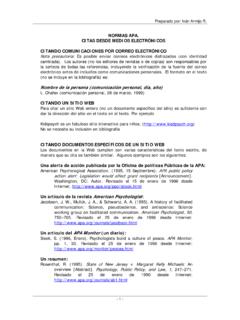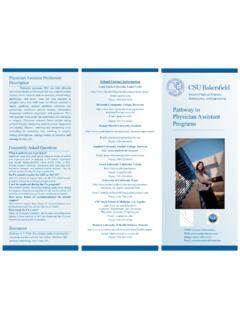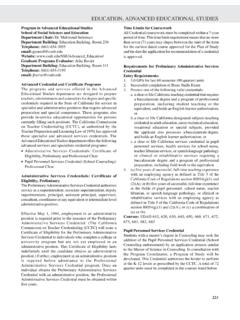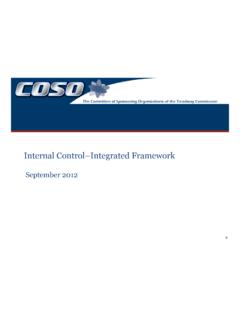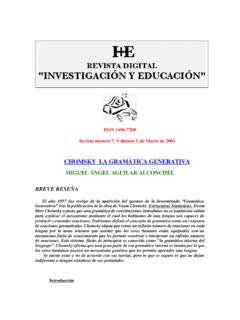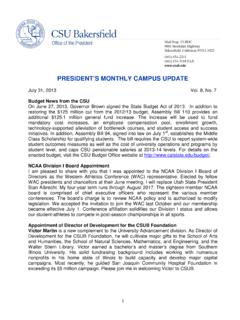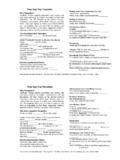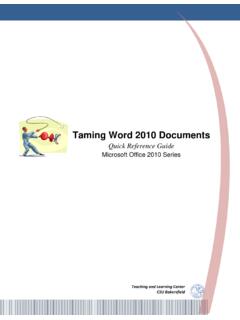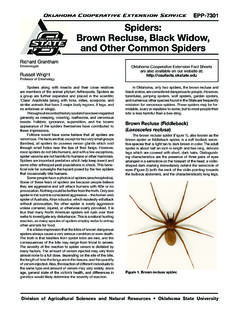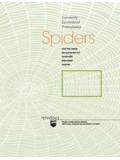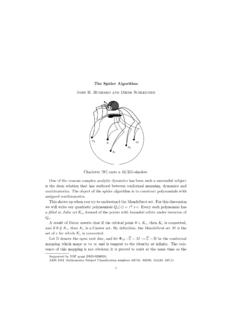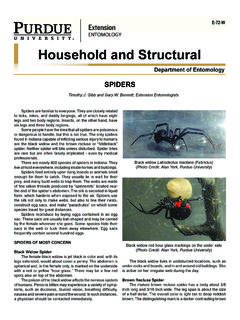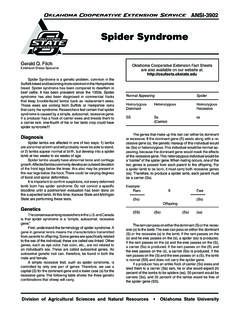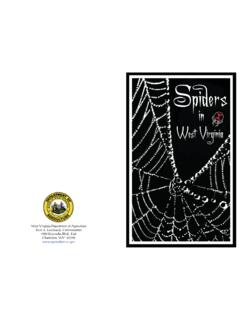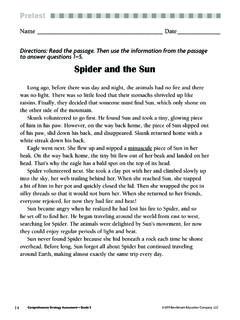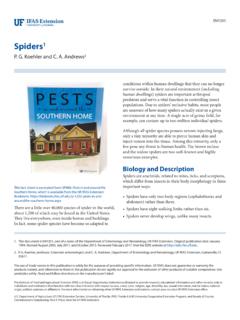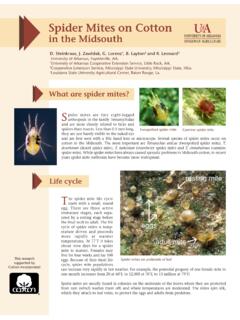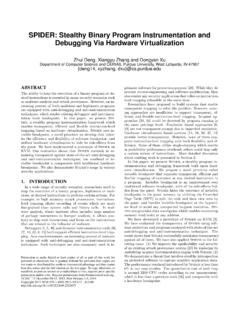Transcription of Guide to common spiders of Bakersfield, California
1 Guide to common spiders of bakersfield , California Carl T. Kloock Department of Biology California State University, bakersfield Last Update: February 25, 2020 Why this Guide ? Identifying spiders can be an incredibly time consuming and frustrating process, and is virtually impossible for the non-specialist. Taxonomic keys frequently rely on characteristics only visible with high power microscopes or, even more problematic, only present in adult individuals. Given that spiders spend the bulk of their lives as juveniles, this can make identification even of the Genus difficult. However, investigating questions regarding spider ecology, evolution and behavior requires identification.
2 My goal with this Guide is to develop an easy to use resource for identifying the local spiders to genus, and to species wherever practical, using characters present on juveniles as well as adults and easily observable with a low-power dissecting microscope or good macro-photography lens without dissection. Preference is given to traits observable to the naked eye whenever possible, but as most spiders are tiny even as adults, magnification is a necessity. My primary goal is to create a teaching resource for my future research students; I have decided to make it generally available in the hope that others may find it useful. Given the desire to focus on easily observable characters present in juveniles, identification to genus is the best practical outcome using this Guide .
3 Because of this, I strongly considered not including species designations at all, but decided that they could be helpful in narrowing down the possibilities, and explaining some of the variation if certain cautions are kept in mind. Given the limited scope of the Guide , there are several disclaimers. One major weakness of macro-level characters is that they are often very similar between congeners. Represented genera can usually be determined well with this Guide without recourse to primary taxonomic works. However, species designations based on these characters should always be considered provisional, and if accurate species identification is required for your purposes, primary works must be consulted (& are cited for convenience).
4 This will usually require adult specimens, magnification >100x, and may require dissection. Species identifications included here are of spiders in the southern San Joaquin Valley found in and around the town of bakersfield , CA. It is possible, maybe even probable, that similar spiders found in nearby locations are different species. Less likely, but still possible, is that they are different genera. Use caution outside of the southern San Joaquin Valley. My research focuses on the Mimetidae, which are nocturnal. Because that is when I do the bulk of my observations, the Guide is certainly biased towards inclusion of nocturnal species. Organization: The next page of the Guide is a list of the species included, with links to their individual descriptions.
5 Next is a key to the local families with pictures to help you identify the traits since verbal descriptions are often problematic. Clicking on the family name in the key will take you to the first page of that family's species descriptions; if more than one species is present, a small key will appear on this page that will Guide you to genera & species. Alternatively, the Guide can be browsed linearly; the families are in alphabetical order with genera alphabetical within family and species alphabetical within genus. Family keys appear on the first page for each family. All species descriptions include photographs of a dorsal view and a ventral view; some have additional photos to help with specific traits or to show the range of variation in that species.
6 The entire document is a work in progress, and as I get better photographs and more specimens, I will continue to expand the Guide . Suggestions for improvement are welcomed. For help with spider external anatomy & terminology, click on spider anatomy on any page. Use of images: Unless otherwise stated, all photographs are my original work; I waive copyright on my photos, but ask that use of any photographs be cited (Kloock, 2020. Guide to common spiders of bakersfield , California ) and would greatly appreciate being informed of any use Go to Species list Go to Key Guide to common spiders of bakersfield , California Acknowledgements: I would like to thank the following people and organizations.
7 For help with spider collections and photography: Abraham Kubli, Donna Noce, Chuck Tam, Ankit Vyas, and the numerous other students who have brought spiders to me. For access to field sites: The Kern County Water Bank Authority, The Panorama Vista preserve, Andy Honig, Sasha Honig, & Kathi Parks. Funding for digital macrophotography equipment was provided by a Research Council of the University grant for Research, Scholarship and Creative Activity, 2011. I would also like express my appreciation for Chevron corporation for funding the CSUB REVSUP program, and the participants of my summer 2012 REVSUP Research Team: Riley Demos, Jessica Laurente, Joel Perez, Greg Gonzales and Pamela Fisher.
8 List of included species (by Family) Agelenidae Pholcidae Hololena sp. Holocnemus pluchei Araneidae Salticidae Larinia famulatoria Phidippus asotus Metepeira sp Phidippus audax Neoscona arabesca Phidippus boei Neoscona oaxacensis Thiodina hespera Clubionidae Sitticus sp. Elaver sp. Sparrasidae Corinnidae Olios sp. Trachelas pacificus Dictynidae Dictyna sp. A Dictyna sp B. Gnaphosidae Tetragnathidae Gnaphosa sp Tetragnatha sp. Herpyllus sp Theridiidae Scopoides sp. Latrodectus sp. Lycosidae Steatoda grossa Geolycosa Theridion californicum Hogna sp. Theridion neomexicanum Mimetidae Thomisidae Mimetus hesperus Xysticus sp. Oecobiidae Oecobius sp. Oxyopidae Oxyopes flavus Uloboridae Oxyopus salticus Uloborus diversus Oxyopes scalaris Peucetia sp.
9 Philodromidae Apollophanes sp. Tibellus Ebo parabolis Guide to common spiders of bakersfield , California Key to Families 1 A. With 1 pair of forward facing eyes obviously larger (>2x) than some other eyes (figs. 1, 2 & 3). There may be a second pair of large eyes, but not forward facing---------------------------------- ----------- 2 B. Not as above; all eyes approximately the same size or larger eyes not facing forward--------------- 4 2 (1) A. Smaller eyes appear laterally -- No eyes below large forward-facing eyes (Fig 1)---Family Salticidae B. With smaller eyes occurring below the large pair of forward-facing eyes (Fig 2, 3)----------------3 3 (2) A. 2 small eyes below & medial to large eyes ( Fig 2)--- ----------------------------------Family Oxyopidae B.
10 4 small eyes below large forward facing eyes ( Fig 3)----------------------------------Fami ly Lycosidae 4 (1) A. Lateral spinnerets readily visible in dorsal view and with bases obviously separated (Fig. 4, 5)--------5 B. Lateral spinnerets not visible in dorsal view or, if visible, without obvious separation at bases. -------6 5 (4) A. Lateral spinnerets cylindrical and held roughly parallel their entire length. Lateral spinnerets without an obvious joint obviously away from body (Fig 4) -------------------------------- Family Gnaphosidae B. Lateral spinnerets conical, with an obvious joint towards the distal end. Often (but not always) bent towards the midline at rest and (Fig 5).

